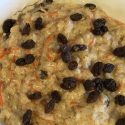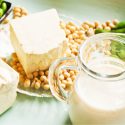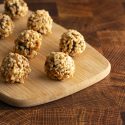Healthy grocery shopping tips
By eating the right foods, you can avoid things like diabetes and heart disease — all while feeling better, losing weight, and being a role model for your friends and family! It all begins at the stocked shelves of your local grocery store, which are piled high with choices.
Between the abundance of information from food labels and various types of marketing on products, grocery shopping can be a daunting task. You are deciding what to put into your body during the upcoming week. However, having a set plan in mind and a grocery list in hand can make grocery shopping easier!
Plan ahead for success
Before heading out the door, plan your meals for the week — or at least have a solid idea of what you would like to have on hand from Monday to Friday. Ask yourself questions like, “How much time will I have to cook?” and, “When and where will I be eating?”
The answers to these questions can help you decide not only what to buy, but how much.
Make a list
You don’t want to rebuy items you already have or spend extra money on your trip. So making a list of what you will need, and also of things you already have in your cupboards will help you stay on track.
Look for sales
Try looking for weekly savings on lean meats like fish, turkey, and chicken; or produce specials like bananas, spinach, and carrots. Choosing fresh items that are on sale not only save you money; they could save you pounds, too!
Eat before you leave
We’ve all been there: in the chip aisle (how did we get there, anyway?!) when hunger starts to take over our healthy intentions. Even a small snack before heading out can make a big difference.
What should be on your grocery list
Produce
The Academy of Nutrition and Dietetics recommends five daily servings of fruits and vegetables. This equates to about one third of your grocery cart space!
Like you’ve heard before, eat the rainbow! Pick fruits and vegetables with a variety of colors. The different colors will help you consume different vitamins, minerals, antioxidants, etc. — all while helping curb your hunger. Although your favorite fruits and vegetables may not be in season all year, there are other options for gathering many different types. Some of these ways include frozen, canned, or trying different in-season fruits and vegetables.
Dairy
Dairy items that typically occupy a grocery cart include milk, eggs, and cheese.
Take a look at the type of milk you’re buying. Whole milk may have more protein than, say, 2% milk, but it is also much higher in fat and saturated fat. The USDA recommends choosing low-fat (1%) or non-fat milk. Don’t forget great milk alternatives too, such as almond, coconut, and soy. These options are great for someone who is lactose intolerant or wants to consume a more plant-based diet. Just be sure to choose the unsweetened versions of the alternatives, as the original flavors have a lot of added sugar!
Did you know that the average American eats about 33 pounds of cheese a year? That’s a lot of cheese, and with that comes a lot of saturated fat. Look for cheeses that are low fat, reduced fat, or nonfat.
Yogurt is another great option to pick up for the week. Some healthy tips for yogurt include nonfat and low-fat yogurts that contain live and active cultures for probiotics that aid in digestion. Choose plain flavors or flavors such as vanilla over fruit-based flavors to avoid the extra sugar and calories. Choose Greek yogurt over whipped to get a good source of protein that will help keep you fuller longer.
Protein
Protein sources range from lean meats to beans and various other options. For meat, the leanest cuts are in the name: top round, bottom round, sirloin, and tenderloin.
Look for “choice” or “select” grades versus “prime” when choosing your cuts of meat. Prime indicates marbling of the meat, meaning higher fat content and calories. Choice has less fat, and select means the leanest cut of meat.
For chicken and poultry, opt for the skinless breast instead of the darker meat to avoid excess saturated fat. For ground turkey and beef, make sure you are looking at a good ratio of meat to fat content, such as 80/20 or above.
The American Heart Association recommends two servings of fish per week. Try salmon, trout, or tuna to mix up your meals and get some healthy protein sources.
Do not feel limited to meat for all of your protein options. Beans, nuts, seeds, and tofu are also great sources of protein that are plant-based and offer a higher variety for meals, along with nutrients and fiber!
Grains
Breads, cereals, and pastas may be in different aisles, but they all fall within the grain category! Have you ever heard someone say, “Make half your grains whole?” It’s a good health tip.
Whole-grain breads include labeling that says “100% whole wheat” or have whole-wheat flour listed as the first ingredient. For pasta, cereal, and cereal bars, opt for the same indicators.
Whole grains are higher in fiber, nutrients, and are low in sugar whereas white breads are considered refined grains. Refined grains are stripped of their nutrients and fiber, and are high in sugar. Whole grains regulate our blood sugar and can protect us from diabetes and stomach upset when compared to refined grains.
For gluten-free options, buckwheat and rice based pastas, breads, and cereals are a great alternative. But don’t feel stuck in just those three examples of grains… try quinoa, brown rice, couscous, and other grains that are both heart-healthy and whole-grain!
Snacks and beverages
Now to the most tempting portion of the grocery store: snacks! Snacks are not something you should completely avoid as deprivation or punishment. Moderation is the key to a healthy lifestyle, so do your best to make the best options out of your favorite snacks. That way, you can still indulge when your cravings are high! Look for things like fresh fruit, dark chocolate, or any low-fat bakery items. For savory and salty snacks, look for chips and crackers that are baked instead of fried and if you can, opt for whole-wheat versions!
Beverages can be tricky. Soda, some juices, and many sports drinks are loaded with added sugar and calories. So what’s the best way to get that yummy taste without the calories?
Opt for diet soda when possible, or even seltzer water with added fruit! For juice, make sure the ingredient list says “100% juice” and lists juice as the first ingredient, and keep the portion size small. Even natural fruit juice is extremely high in calories without the fiber you get from the raw fruit. Instead of sports drinks, try unsweetened tea or no-calorie water infusers.
You don’t have to dread grocery shopping. Your trip to the store can be used as an action plan improve your health and quality of life. You will feel better, and your body will too!




